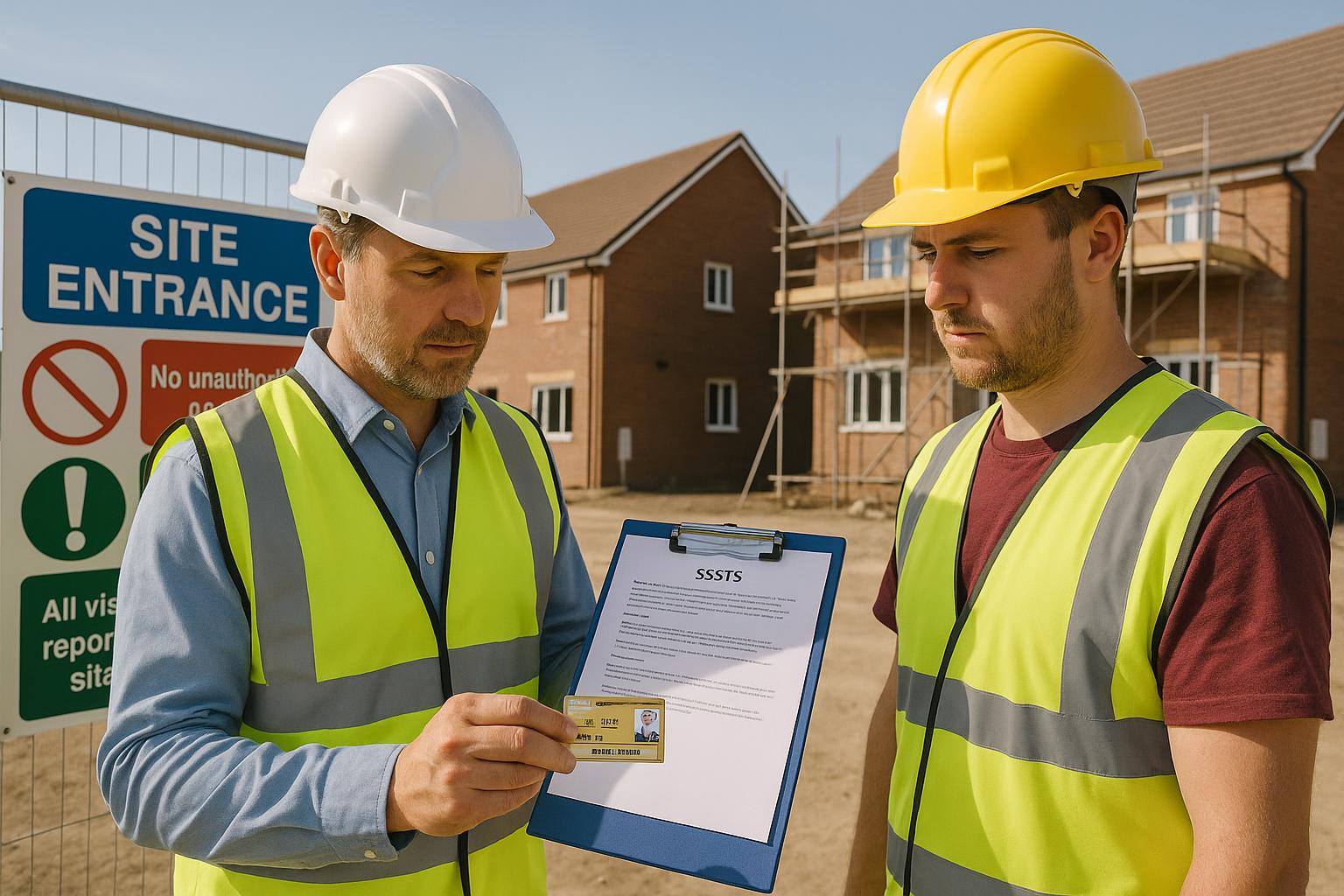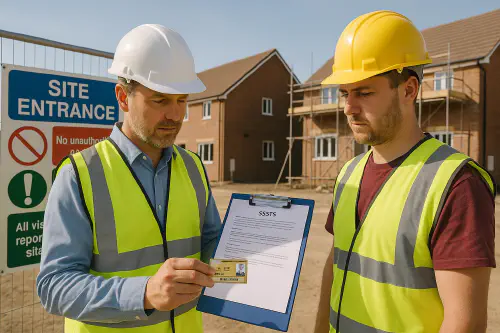
Site supervisor competency checklist: CSCS Gold, SSSTS or SMSTS, NVQ levels and practical tests
Category: Hiring, Training & HR • Niche: hiring site supervisors, competence, CSCS Gold, SSSTS, NVQ

Supervisor checking CSCS Gold Supervisor card and SSSTS certificate on a small housing site
Contents
- Quick answer
- What does competent mean under CDM 2015
- CSCS Gold Supervisor card: what you actually need
- SSSTS vs SMSTS: which one for supervisors
- Hiring flow: a simple, fair way to test competence
- Practical tests you can run in 60 minutes
- Evidence pack to keep for audits and clients
- First aid cover quick reference
- One-page supervisor competency matrix (template)
- Contract wording and supervision frequency
- Recommended tools and automations
- See SSSTS explained (video)
- What are people saying on Reddit
- FAQ
Quick answer
- Under CDM 2015 you must provide appropriate supervision. HSE looks for proportionate proof: skills, knowledge and experience, plus the right training for the tasks being supervised. See HSE guidance on supervision and CDM duties for contractors and principal contractors.
- CSCS Gold Supervisor card proves you hold an approved supervisory NVQ or SVQ (usually Level 3 or 4) and have passed the CITB Supervisors HS&E test in the last 2 years. SSSTS alone does not qualify you for the Gold card.
- SSSTS is the baseline safety course for supervisors. SMSTS is usually for site managers. Many contractors expect SSSTS for supervisors and SMSTS for managers, but check your client’s policy.
- Do not rely on cards alone. Run practical, job-relevant tests: review RAMS, deliver a toolbox talk, spot hazards in photos, and complete a supervision log. Keep the evidence.
Helpful links:
- HSE CDM 2015 overview and duties: hse.gov.uk/construction/cdm/2015
- HSE on supervision: hse.gov.uk/humanfactors/topics/supervision.htm
- CSCS Supervisory card: cscs.uk.com/card-type/supervisory
- CITB SSSTS: citb.co.uk
What does competent mean under CDM 2015
Competence is not just a card. Under CDM 2015, contractors and principal contractors must plan, manage and monitor work and provide appropriate supervision so work is carried out without risks. Supervisors must have the right skills, knowledge, experience and training for the tasks they oversee.
- Duties: see HSE on contractors and principal contractors.
- Practical take: if the person cannot brief RAMS, spot obvious hazards or stop unsafe work, they are not competent, regardless of cards.
CSCS Gold Supervisor card: what you actually need
- A relevant supervisory/technical NVQ or SVQ at Level 3 or 4 (for example, NVQ Level 4 Construction Site Supervision or Level 3 Occupational Work Supervision).
- CITB Supervisors HS&E test passed within the last 2 years.
- Apply via CSCS. The card is valid for 5 years.
References:
- CSCS Gold Supervisory card requirements: cscs.uk.com
- NVQ Level 4 example: City & Guilds 6577 Construction Site Supervision
- CITB HS&E test info: citb.co.uk
SSSTS vs SMSTS: which one for supervisors
- SSSTS: 2 days. Designed for current or aspiring site supervisors. Covers legal responsibilities, toolbox talks, and day to day control. Certificate valid 5 years.
- SMSTS: 5 days. For site managers. Deeper into planning, managing and monitoring the construction phase.
References:
- SSSTS overview: CITB SSSTS
- SMSTS overview: CITB SMSTS
Hiring flow: a simple, fair way to test competence
Use this process for internal promotions or new hires. It is quick, repeatable and proportionate for small contractors.
Steps:
- Pre screen: check years on the tools, prior responsibility, references.
- Evidence check: NVQ L3 or L4 in supervision, CSCS Gold Supervisory, SSSTS or SMSTS, and HS&E test date.
- Practical tests: RAMS review, run a 5 minute toolbox talk, hazard spotting from site photos.
- Paid trial shift: shadow on a live job, complete a simple supervision log.
- Decision and training plan: confirm authority to stop work, agree refresher training and card renewal reminders.
Practical tests you can run in 60 minutes
- RAMS red pen: give last week’s RAMS. Ask them to highlight missing controls and brief the changes.
- Toolbox talk: ask them to deliver a 5 minute talk on ladder use or manual handling to two people.
- Hazard spotting: 10 annotated photos of a typical site. Ask them to mark hazards and controls.
- Supervision log: ask them to complete a short supervision record from a mock shift.
- Escalation: give a scenario where a subcontractor refuses a guardrail. Ask how they will stop work and escalate.
Score each test 0 to 2. Keep the sheets as evidence.
Evidence pack to keep for audits and clients
Keep these in your job folder or company competency matrix. This helps with client pre quals and the golden thread.
- Copies of cards and certs: CSCS, SSSTS or SMSTS, first aid where relevant.
- NVQ certificate or current registration if still completing. If in progress, you can use the CSCS Experienced Technical, Supervisor or Manager card while finishing.
- Supervision logs from trial shifts and the first two weeks on site.
- RAMS brief records and toolbox talk sign offs.
- First aid cover plan per shift. See quick reference below.
- Renewal reminders for cards and HS&E tests. See our renewals automation guide.
Related Academy guides:
- Automate renewals for cards and courses: Automate CSCS, CPCS and SMSTS renewals
- Build a digital health and safety file: Health and safety file workflow
First aid cover quick reference
HSE guidance for construction sites:
- Fewer than 5 workers: at least 1 appointed person.
- 5 to 50 workers: at least 1 trained first aider (EFAW or FAW as your risks require).
- More than 50 workers: at least 1 FAW trained first aider for every 50 people or part thereof.
Source: HSE first aid in construction FAQs and the employer guidance on first aid needs assessment.
One-page supervisor competency matrix (template)
Copy this into your folder for each supervisor and update quarterly.
| Area | Evidence | Score 0 2 | Notes |
|---|---|---|---|
| Legal basics (CDM 2015, duties) | SSSTS certificate, induction test | ||
| CSCS and NVQ | CSCS Gold Supervisor, NVQ L3 or L4 | ||
| RAMS briefing | Observed toolbox talk, sign offs | ||
| Hazard recognition | Photo test score, close calls reported | ||
| Stop work authority | Example escalation logged | ||
| Supervision records | Daily or shift log examples | ||
| First aid coverage awareness | Shift plan meets HSE numbers | ||
| Plant and permits | Spot checks signed correctly | ||
| Communication | Client updates, WhatsApp summaries | ||
| Training plan | Next courses booked, renewals set |
How to use scores:
- 0 needs training. 1 acceptable with support. 2 independent.
- Aim for 16 or more to sign off as competent supervisor. Record your decision and the date.
Contract wording and supervision frequency
Add clear duties and authority in contracts or assignment letters.
Include statements such as:
- You will plan, manage and monitor work in your area and provide appropriate supervision to ensure health and safety.
- You will stop work that cannot be carried out safely and escalate immediately to the site manager or principal contractor.
- You will brief RAMS and record attendance for toolbox talks.
- You will complete a daily supervision log noting checks, issues and actions.
Frequency suggestion for small sites:
- Start up: 1 hour per shift across each active work area.
- Steady state: at least 15 minutes per hour walk rounds if multiple trades in the same…